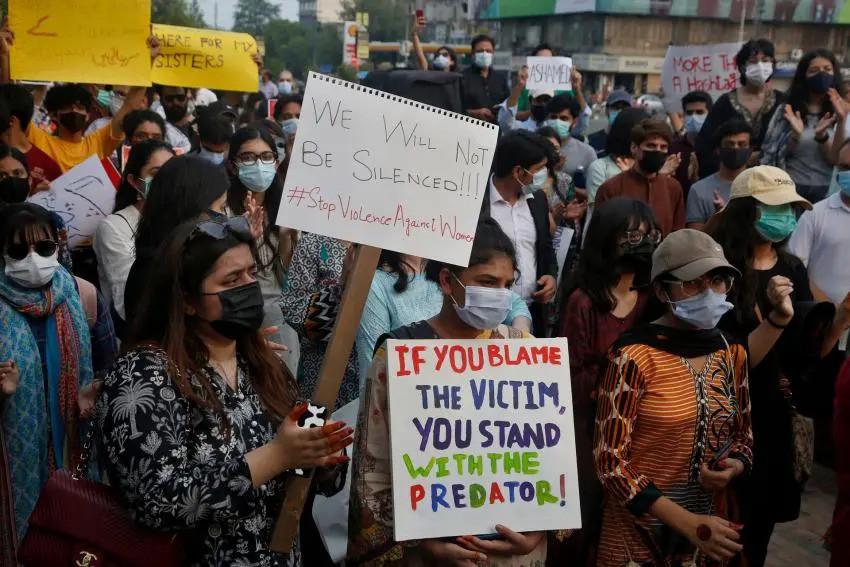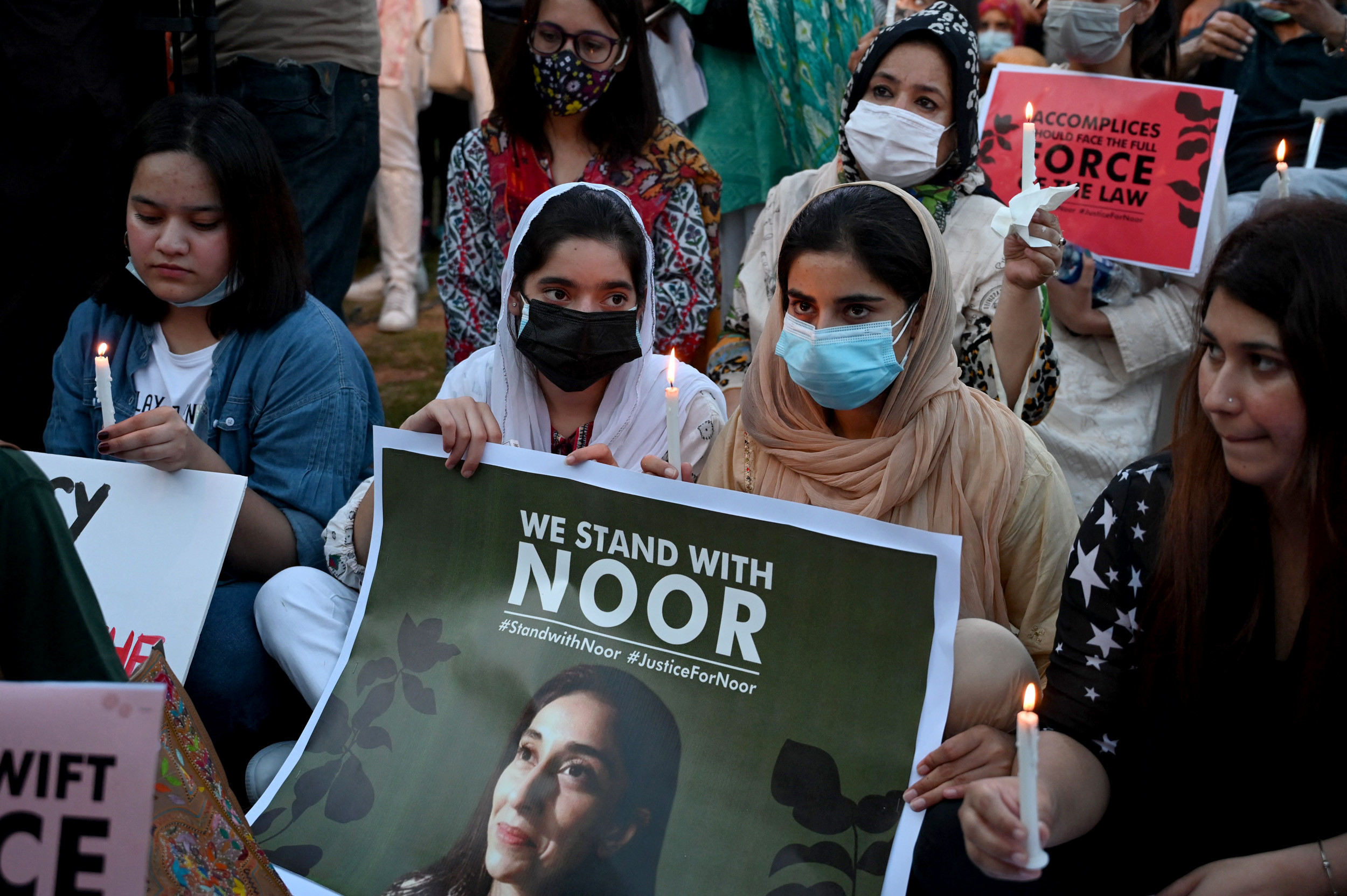In July 2021, 27-year-old Noor Mukadam, daughter of former ambassador Shaukat Mukadam, was held hostage for two days, tortured with a knuckleduster, then decapitated with a knife, by her friend, 30-year-old Zahir Jaffer, son of an influential family. The murder was premeditated as Jaffer reportedly confessed to police that he intended to kill Noor if she refused his marriage proposal. According to reports, data recovered from Jaffer’s phone indicated he had been involved in violence against women in the past as well.
In September 2022, Sarah Inam, a Canadian national and a successful economist, was killed by her husband Shahnawaz Amir, son of prominent columnist and politician Ayaz Amir, presumably with a dumbbell at a farmhouse in Chak Shahzad, a suburb of Islamabad. She got married to Shahnawaz just three months before being murdered. It is believed the couple knew each other before marriage which was of their own choice, not arranged by their families.
In January 2023, the body of 23-year-old Sara Malik, physical therapist cum receptionist at an upscale pet care centre in Karachi, was found at Seaview. Initially it was believed that she had committed suicide, however post mortem indicated that she might have been murdered. According to reports she had intimate relations with the hospital owner, Dr Shan Saleem, who was booked and arrested for allegedly sexually abusing and murdering her.
The above mentioned cases show the horror of violence against women perpetrated in our society. These took place within a span of 18 months, but are not the only cases of violence to have occurred during this time period. What makes them stand out is that they happened in the upper strata of society.
Till some time back, one would only hear of violence being perpetrated in lower or middle class set-ups, and upper and upper-middle classes were assumed to be free of this evil practice. But the cases of Noor Mukadam, Sara Inam, and Sara Malik show that violence is not limited to any class and is as prevalent in upper classes as in others. The only difference is that violence, especially domestic violence, in upper classes is hidden and not talked about. The cases mentioned above attracted attention through social media and the perpetrators in all three were arrested.

“Violence against women has always been present in upper classes, but it was a topic not much talked about as upper class women are more image conscious, though now they have begun to acknowledge it,” says Dr Asha Bedar, clinical psychologist and trainer on issues related to gender, abuse, and trauma. “Whereas in the working class one could immediately tell what happened when the maid comes in to work with bruises and body ache. It was a hush-hush matter in the upper classes, and kept discreet. Women would try to hide their bruises using makeup, wearing sunglasses, etc. so no one gets to know what was happening.
“Also, women from upper classes have more choices, they can opt for separation or divorce; also they can distract themselves by going to coffee parties, or opting for a hobby etc. while having no options, poor women have to bear it while staying in the same surroundings,” she says.
Dr Nargis Asad, Associate Professor and Chair Department of Psychiatry, Aga Khan University Hospital believes that violence has always been present. “Because recognition has increased and people are speaking up, it appears that it has increased,” she says. “While in the past nobody, especially from the upper classes would accept that violence has taken place and would try to hide it, people have now begun to acknowledge it and their families have also become supportive.”
What makes men, especially well-educated ones, to resort to violence of the worst kind?
“The reasons are more or less the same in all social strata — power and desire to control, be it through mobility control or economic control, or whatever,” says Dr Bedar. “The nature of violence changes, but dynamics and reasons remain the same, i.e. misogynistic attitude. Violence is not just physical, it occurs in various forms such as manipulation, mental abuse, and wish for control. Harassment is not considered violence, though it is a form of violence. It is often accepted as part of life.”

Dr Nargis Asad, Associate Professor and Chair Department of Psychiatry, Aga Khan University Hospital, feels that the only reason for violence against women across the board is the control factor. “There are other factors but they trigger and fuel the control factor, and are not the primary factors,” she says.
For instance, socio-economic factors worsen it, when a man comes home and does not get food or asks for money from his wife and she denies it, or any other need of his is not met he gets angry and resorts to violence as he considers it as a controlling tool.
“The patriarchal mind-set is also to be blamed,” says Dr Asad. When the man knows that the woman would not hit back or retaliate, he feels free to treat her in any way he likes.
There is a general acceptance of violence in society both by men and women and that harms the social environment and moral fabric of the society. For most men, raising a hand on a woman is justified as they consider her weak, requiring disciplining from her husband. Beating and thrashing a woman seems normal to the men in our society who have no regard for the dignity of women.
While most people condemn gender-based violence, many support the patriarchal norms that are ingrained in a child’s mind from early childhood, which include ideas that men are naturally violent and angry, and that women should be patient and tolerant. From a young age, boys are encouraged to be ‘strong’ and aggressive and women are taught to compromise. It starts with the sensitisation of a child, what you’re teaching them, and what they’re exposed to.
“The problem is that the society on the whole, especially parents, teach aggressive behaviour to boys,” says Dr Asad. “Since early life they are told that men need to be strong and it is okay to be aggressive and use power, so they grow up to be aggressive and controlling. Our culture and media also teaches that men should be in control, and accepts that men can do anything from economic and mobility control to hitting and abuse.”
According to Dr Bedar women have internalised this attitude. “Saying that ‘boys will be boys’, and that women should conform supports this attitude,” she says. “We see this in TV dramas as well as on social media. Women are blamed for going out at night (the motorway case where a woman was ambushed and gang raped in front of her two children, a senior police officer blamed the woman saying she shouldn’t have been travelling at night and without a man), or for their dressing” — why did she wear such a dress, she was inviting trouble. Violence against women depicts social mentality and male power, and takes place when men want to impose their opinion, mentality, and power on women. In fact, it is the overall power dynamics in society. It is not just illiterate, uneducated men who perpetuate violence but seemingly well-educated and well-dressed men belonging to the elite classes too resort to violence.”
To justify resorting to violence, the use of alcohol is often blamed, i.e. the person was under the influence of alcohol and didn’t know what he was doing. However, Dr Bedar refutes this, saying, “alcohol can trigger violence but it is not the root cause, as not all alcoholics are violent or rapists.”
Whatever the factors behind this trend may be, there is a need to curb violence, especially extreme violence where women are killed just because they disagree or are not ready to conform to the norms set by the society.
Numerous laws have been enacted in the country to curb violence against women, but their enforcement remains weak. The patriarchal nature of our society does not recognise women as equal citizens, and this discrimination leads to violence and killing of women.
Women in Pakistan face inequality on all fronts and this is a cause of serious concern. In the latest Global Gender Gap Report released by the World Economic Forum (in July 2022) Pakistan has been ranked as the second worst country in terms of gender parity, placed at 145 out of 146 states. The country ranked 145 on economic participation and opportunity, 143 on health and survival, 135 on educational attainment, and 95 on political participation.
Violence against women is one of the most prevalent human rights violations across the globe. A UN report on femicide released on November 25, 2022, the International Day for the Elimination of Violence against Women, revealed that every 11 minutes a woman or girl is killed by an intimate partner or a family member. These are chilling statistics, all the more so because they are merely the tip of the iceberg; a large number of cases go unreported and unaccounted for.
Pakistan is no exception. Violence against women is rampant and remains a serious problem, despite efforts in recent years to introduce laws to protect women. It is estimated that in Pakistan, 32 percent of women have experienced violence in one form or another, be it physical, sexual, or psychological, including rape, murder, acid attacks, domestic violence, and forced marriage.
What can be expected in a society where the sitting prime minister encourages misogyny? A month before Noor Mukadam’s murder, then PM Imran Khan was accused of victim-blaming and misogyny when he suggested that the rise in rape and assault cases in the country were partly to be blamed on how women dressed and behaved. “If a woman is wearing very few clothes, it will have an impact on men unless they are robots,” Mr Khan had said in an interview.
In July 2021, women rights activists criticised the government’s decision to refer the bill that sought to criminalise domestic violence to the Council of Islamic Ideology (CII) for review. The CII criticised the bill saying that it contained “un-Islamic injunctions” and would destroy the institution of the family. The bill failed to pass through the Parliament.
Rights activists believe that the misogynistic mind-set is so deeply rooted in our society that it will take years to bring any real change.
Rizwana Naqvi is a freelance journalist and tweets @naqviriz; she can be reached at naqvi2012rizwana@hotmail.co.uk. All facts are information are the responsibility of the writer
